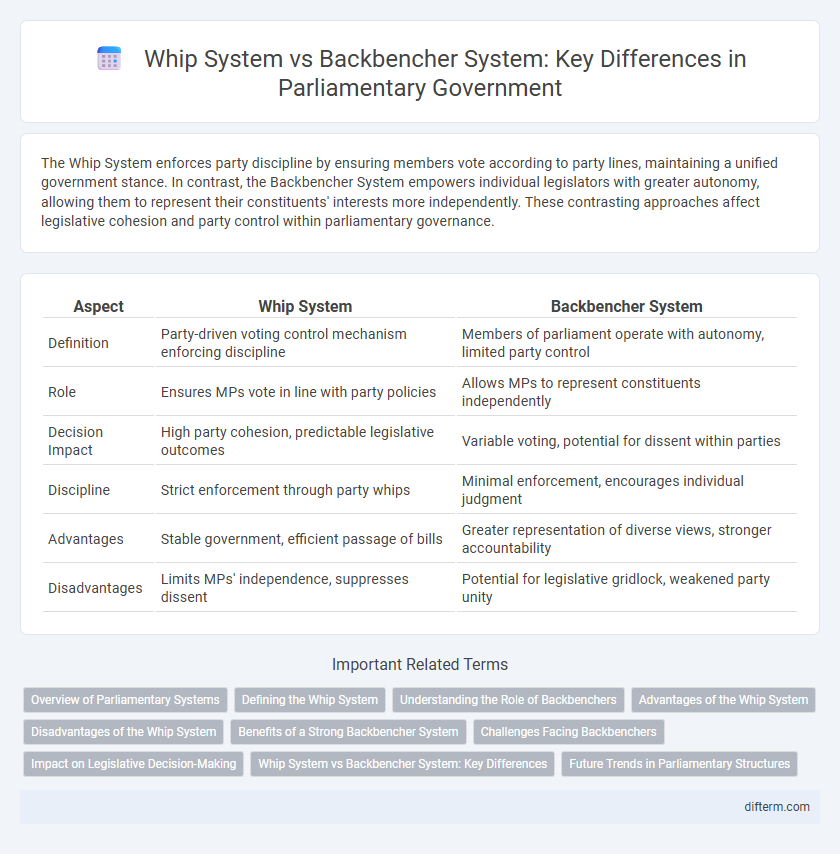The Whip System enforces party discipline by ensuring members vote according to party lines, maintaining a unified government stance. In contrast, the Backbencher System empowers individual legislators with greater autonomy, allowing them to represent their constituents' interests more independently. These contrasting approaches affect legislative cohesion and party control within parliamentary governance.
Table of Comparison
| Aspect | Whip System | Backbencher System |
|---|---|---|
| Definition | Party-driven voting control mechanism enforcing discipline | Members of parliament operate with autonomy, limited party control |
| Role | Ensures MPs vote in line with party policies | Allows MPs to represent constituents independently |
| Decision Impact | High party cohesion, predictable legislative outcomes | Variable voting, potential for dissent within parties |
| Discipline | Strict enforcement through party whips | Minimal enforcement, encourages individual judgment |
| Advantages | Stable government, efficient passage of bills | Greater representation of diverse views, stronger accountability |
| Disadvantages | Limits MPs' independence, suppresses dissent | Potential for legislative gridlock, weakened party unity |
Overview of Parliamentary Systems
The Whip System in parliamentary governments enforces party discipline by ensuring members vote according to party lines, enhancing legislative efficiency and government stability. In contrast, the Backbencher System allows greater individual autonomy for non-ministerial legislators, fostering diverse viewpoints but potentially leading to less cohesive party strategies. Understanding these systems is crucial for analyzing legislative behavior and power dynamics within parliamentary democracies.
Defining the Whip System
The Whip System in government refers to the organizational mechanism used by political parties to ensure party discipline and manage legislative voting. Whips communicate party positions, rally support, and reinforce member compliance to maintain unity and achieve legislative goals. This system contrasts with the Backbencher System, where individual legislators exercise greater independence without strict party control.
Understanding the Role of Backbenchers
Backbenchers play a crucial role in parliamentary governance by representing constituents' interests without holding ministerial office, ensuring diverse views within the legislature. Unlike the whip system that enforces party discipline and voting alignment, backbenchers exercise independent judgment, often influencing policy through committee work and private member bills. Their ability to hold the executive accountable strengthens democratic processes and promotes transparency in government decision-making.
Advantages of the Whip System
The Whip System enhances legislative discipline by ensuring party members vote according to party lines, promoting cohesive policy-making and reducing legislative gridlock. It strengthens government stability by minimizing dissent within the ruling party, allowing for smoother passage of bills and efficient governance. Moreover, the Whip System facilitates clear communication channels between party leadership and members, improving coordination and strategic planning in parliamentary sessions.
Disadvantages of the Whip System
The Whip System often restricts individual legislators' autonomy, leading to reduced debate and critical examination of policies in government. It may foster an environment where party loyalty overrides constituency interests, undermining representative democracy. Furthermore, the system can contribute to political polarization by enforcing strict party discipline and discouraging cross-party collaboration.
Benefits of a Strong Backbencher System
A strong backbencher system enhances democratic governance by empowering legislators to independently scrutinize policies and government actions, fostering accountability and transparency. It encourages diverse viewpoints in parliamentary debates, leading to more robust and well-rounded legislation that reflects broader public interests. Additionally, an assertive backbencher presence can mitigate the dominance of party whips, promoting a balance of power and reducing the risk of authoritarian decision-making within government structures.
Challenges Facing Backbenchers
Backbenchers face challenges such as limited influence over legislative decisions due to party discipline enforced by the Whip System, reducing their ability to represent constituent interests effectively. They often struggle with restricted access to policy-making discussions and resources, hindering their contributions to meaningful debates. This marginalization exacerbates difficulties in balancing party loyalty with personal or regional priorities, impacting overall parliamentary effectiveness.
Impact on Legislative Decision-Making
The Whip System centralizes party discipline, ensuring legislators vote according to party lines, which streamlines decision-making and enhances policy coherence within the government. In contrast, the Backbencher System empowers individual legislators with greater autonomy, fostering diverse viewpoints but potentially leading to fragmented or inconsistent legislative outcomes. The efficiency of passing laws tends to be higher under the Whip System, while the Backbencher System may encourage more representative and deliberative governance.
Whip System vs Backbencher System: Key Differences
The Whip System enforces party discipline by ensuring members vote according to party lines through appointed officials known as whips, while the Backbencher System grants legislators greater independence, allowing them to vote based on personal conviction or constituency interests. In parliamentary democracies like the UK and India, the Whip System centralizes control, enhancing party cohesion and legislative efficiency, whereas the Backbencher System encourages diverse viewpoints and individual accountability. These contrasting approaches impact legislative behavior, with the Whip System prioritizing uniformity and the Backbencher System promoting autonomy within government structures.
Future Trends in Parliamentary Structures
Future trends in parliamentary structures indicate a shift towards more flexible Whip Systems that balance party discipline with individual autonomy, promoting diverse representation and responsive governance. The traditional Backbencher System may evolve to enhance the influence of non-ministerial MPs through improved committee roles and digital engagement tools. Emerging democracies increasingly adopt hybrid models combining strict party whips with empowered backbenchers to foster transparency and accountability in legislative processes.
Whip System vs Backbencher System Infographic

 difterm.com
difterm.com